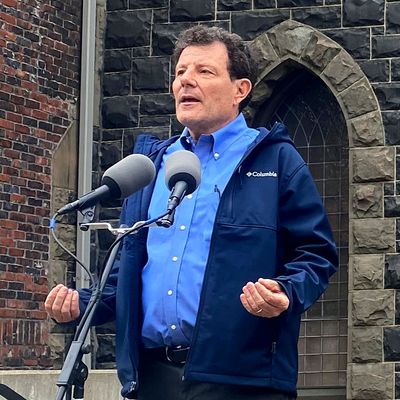
When longtime New York Times reporter and columnist Nicholas Kristof left the Gray Lady and announced a campaign for governor of his native Oregon, it raised a lot of eyebrows among his readers and fellow journalists. Was this a transition-to-retirement project (Kristof is 62), the fulfillment of a private fantasy, or even a sign of hubris? After all, he is best known as an international affairs writer and crusader, winning Pulitzers for coverage (along with his wife, Sheryl WuDunn) of the Tiananmen Square protests in 1990 and of the Darfur genocide in 2006.
But Kristof is also famously rooted in a family cherry farm in rural Yamhill, Oregon, and has written often about the tragedies of joblessness, homelessness, and substance abuse that have stricken many of his childhood friends and people in other rural and small-town communities hit hard by globalization and left for dead by the Zeitgeist. Just last year, he and WuDunn published a book (later made into a documentary) on the subject, based in part on his examination of conditions in Yamhill. And it’s a theme he picks up on without a beat in the video he released announcing his first run for office:
It’s an interesting story all right — one that links his international experience with his journey from and then back to Oregon. But can it really work in a statewide election? Is “Kristof for Governor” going to be an effort that New Yorkers care about more than the Oregonians who will adjudge it at the polls (or in the mail, in this 100 percent mail-ballot state)? Is he a serious candidate?
In a word, maybe. Yes, he is vulnerable to the charge that he has packed up a carpet bag and descended on his native state from the commanding heights of a journalism profession that is not respected much more than politics these days. The fact that he voted in New York in 2020 will be mentioned often by his rivals and detractors. But on the other hand, Oregon is a state in the grip of something of a leadership vacuum and is struggling with precisely the sort of problems Kristof seems prepared to address. Term-limited Democratic Governor Kate Brown is very unpopular. There is no obvious heir apparent among Democrats, and Oregon’s outgunned and divided Republicans don’t seem positioned to win the governorship for the first time since 1986.
Portland, the city that has traditionally dominated the state and especially the Democratic Party, is now widely regarded as being in a state of poorly managed crisis. John Horvick of the public opinion firm DHM Research told me that after years of finding the economy and education as the dominant public policy issues for Oregonians, right now they have been eclipsed by “homelessness, affordable housing, and crime,” with anti-Portland sentiment growing even in that city’s suburbs. It’s worth noting that Kristof’s most obviously formidable rival, Oregon House Speaker Tina Kotek, represents a Portland district and is the perceived favorite of the state’s powerful (and often resented) public employees unions. While only about 20 percent of the vote will be from nonmetropolitan areas, Kristof’s small-town background could give him a base from which to build.
In terms of Kristof’s strategy, it’s important to understand that while all three Pacific Coast states now embrace near-universal voting by mail (or as its proponents prefer, “at home,” since many ballots are dropped off rather than mailed), Oregon differs in a crucial respect from California and Washington, which have abolished party primaries in favor of a top two system. Oregon has closed party primaries, barring participation from unaffiliated voters. It also doesn’t have any majority-vote requirement to win primaries. With just over a third of Oregon voters being registered Democrats, and given a multicandidate field with Kotek and State Treasurer Tobias Read already running, it means someone could win with a relatively small portion of a relatively gray-haired and well-educated primary electorate. But the landscape also means that the independent voters who might be attracted to Kristof as an “outsider” candidate won’t be a factor until the general election. Though the journalist is generally known as a progressive, he has made comments about “cancel culture” that may alienate some progressive voters while attracting moderates.
Whoever gets the Democratic nomination will be the odds-on favorite to win in November, even in a Republican-leaning midterm cycle, though the situation is complicated by the independent candidacy of centrist Democratic legislator Betsy Johnson, who has a significant following.
It’s unclear whether Kristof has a viable plan for financing his campaign, though he is well positioned to put together a national small-donor base rooted in his Times readership. And no one at this point knows how well he will perform in retail campaigning. The flip side of being a celebrity “outsider” is that any gaffes he commits will immediately draw attention. And the campaign will be more of a sprint than a marathon: The primary is in May, with voting via mail ballot beginning a couple of weeks earlier.
Oregon is one state where there is precedent for journalists turned politicians. Two-term Governor Tom McCall (1967 to 1975) was a newspaper, radio, and television journalist before entering politics. And before he became a U.S. senator in 1955, Richard Neuberger was a reporter for — wait for it — the New York Times. Maybe Kristof can make that an Oregon tradition.






























